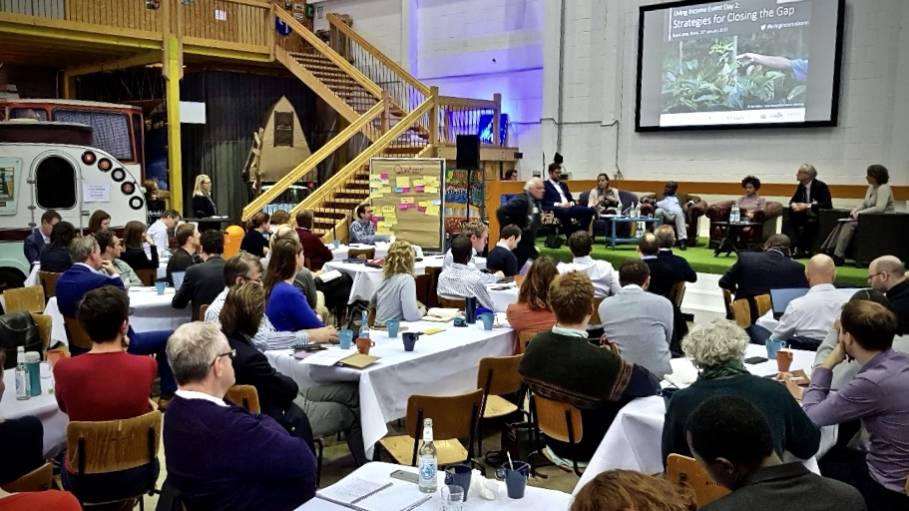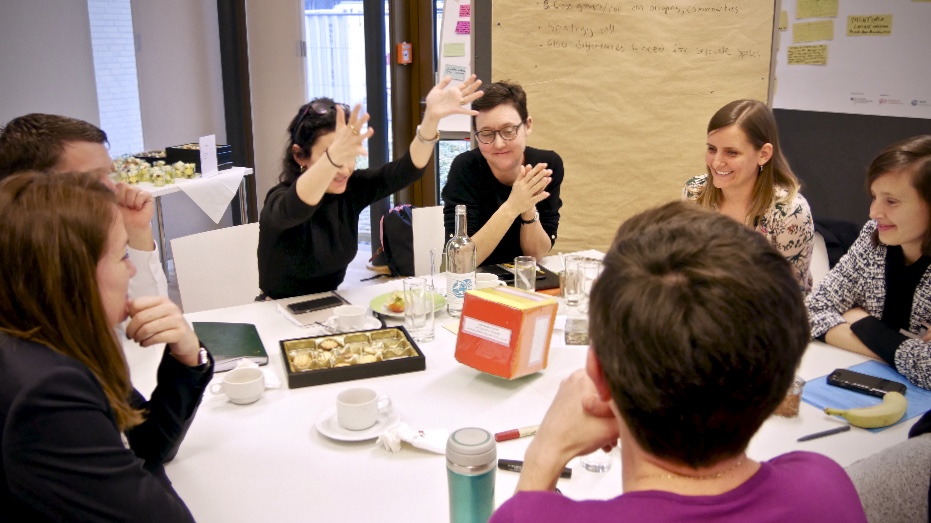Working Towards a Living Income for Smallholder Farmers
Report from the annual workshop of the Living Income community of practice
Building on the results from previous meetings, this year’s workshop in Bonn supported exchange between sectors working on farmer income. It aimed at promoting dialogue, collaboration and action towards addressing global poverty challenges in the agricultural sector, all based on the concept of living income and living wages.

Panel discussion on the roles and levers of different actors for improving farmer income
© ISEAL Alliance
The workshop’s agenda aligned with the community’s two main fields of action. Day 1 focused on measurement methodologies, with the aim of promoting alignment and guidance on best practices for calculating living income benchmarks, actual household income and the income gap. The main goal of the second day was the exchange of ideas and learnings on the effectiveness of strategies to close the gap between actual household income and a living income.
Day 1
The first workshop session discussed the conditions for the validity and credibility of living income benchmarks, based on the lessons drawn from the benchmark studies in Ghana and the Côte d’Ivoire. In a subsequent panel discussion, representatives from the Lindt Cocoa Foundation, GIZ and Rainforest Alliance explained their way forward in using the results of the benchmark studies. GIZ, for instance, wants to support the development of a fast-track method for calculating living income proxy benchmarks.
A parallel breakout session, held by the Royal Tropical Institute (KIT), COSA and Olam International addressed the challenges of measuring actual household income and calculating the income gap. Some of the major prevailing difficulties include the quantification of the production value for own consumption purposes as well as the variety of income sources.
In order to evaluate the impact of different interventions, household income also needs to be tracked over time. In a subsequent session, Mondelez, Rainforest Alliance and COSA reported on their practical experiences with monitoring household income. For instance, COSA’s approach builds on estimating household income based on a certain set of proxy indicators that correlate with income.
A last session, moderated by the Living Wage Lab, addressed the interlinkage between the topics of living income and living wages. The participants discussed the commonalities and differences in working towards living wages and living incomes, and how the alignment of strategies and activities needs to improve in order to address both concepts.
Providing a great basis for a continued discussion, the European conference on living wages and living income was announced, to be hosted by GIZ and the Living Wage Lab in the Netherlands in autumn 2019.
Results of day 1
Overall, the first workshop day stimulated a great momentum of discussion and exchange among the different stakeholders. During the closing session, the following key outcomes were formulated:
- The discussion on measurement approaches should be led in the context of developing impactful tools that can finally inform strategies and action to increase farmer income.
- Fast-track measurement concepts, even if less precise and robust, could be used as an intermediate solution to inform quick action.
- There is a great interest and need for guidance documents and tools that support a harmonized calculation of living income benchmarks, actual incomes and the income gap.
- A platform for sharing data related to living income and wages could help scaling up action.
Day 2
Attendance increased even further on the second day, with more than 100 participants from a diverse group of stakeholders and different sectors.
In his welcoming speech BMZ’s Deputy Director-General Stefan Schmitz emphasized that strategies to increase farmer income should also take into account local value chains in the producer countries, not only global supply chains.
The subsequent session provided a framework to the scope of potential strategies and their interlinkages, based on recently published papers by Aid Environment “Strategies to close the living income gap of smallholder farmers” and the Farmer Income Lab “What works to increase smallholder farmers’ income – A landscape review.
In a second session, panelists from different stakeholder groups, including government representatives of consumer countries and producer countries, standard-setting organizations and the private sector presented their roles in tackling poverty and low farmer income.
Afterward, participants split up into breakouts to discuss specific strategies for raising smallholder incomes in more detail. One session focused on the topic of affordable finance for smallholder farmers, the other one on pricing and trading models for more inclusive and fair global value chains. In the latter session, the Dutch chocolate producer Tony’s Chocolonely presented their five sourcing principles, which also include the payment of living income to their contracted cocoa farmers. Fairtrade International introduced their concept of the Fairtrade Living Income Reference Price, which defines the farm gate price that needs to be paid for a kilogram of raw cocoa in order to provide the farmer with a living income.

Throwing dices – An interactive exercise to discuss similarities and challenges of
jointly working towards living wages and living incomes. © GIZ
Another breakout session in the afternoon addressed the specific role of governments of consumer and producer countries in working towards living income for cocoa farmers. Els Healterman from the Belgian Ministry of Foreign Affairs outlined the goals of the Beyond Chocolate partnership which was signed in December by the Belgian chocolate and retail sector, civil society, social impact investors and universities to promote sustainable Belgian chocolate. Among other objectives, the members committed themselves to achieve living incomes for farmers that produce cocoa for Belgian chocolate by 2030. Mamadou Gbongue from the Conseil Café-Cocoa (CCC) in Côte d’Ivoire outlined the envisaged interventions to improve living conditions for local cocoa farmers. According to Mr. Gbongue, the CCC intends to set a higher floor price for cocoa that is indexed to living income. Also the introduction of a production quota for Ivorian cocoa was discussed as a potential approach.
Furthermore, the topic of crop diversification was addressed as another potential strategy for higher, and especially more resilient incomes of smallholder farmers. During that session, several challenges and conditions for promoting diversification were discussed based on practical examples from the cocoa, coffee and vanilla sectors.
A final plenary session provided a comprehensive overview on the progress of the Malawi Tea 2020 partnership. The multi-stakeholder initiative is composed of private tea companies and retailers, NGOs, the Tea Association of Malawi, tea producers, trade unions, certification standards and the public sector. That diverse set of stakeholders joined forced to work towards a profitable and competitive Malawian tea sector which enables tea workers a living wage and smallholder farmers a living income. One of the key success stories of the partnerships includes the introduction of the industry’s first ever collective bargaining agreement which finally resulted in wage increases beyond the inflation rate.
Day 2 was closed by three further breakout sessions that addressed commodity-specific strategies for closing the income gap for farmers and workers in the cocoa, coffee and tea sectors. During the session on cocoa, the just recently formed task force living income introduced its first ideas for tackling low farmer income from a high-level, policy-based perspective. The key topics that shall be addressed include supply management, procurement practices, farm gate prices and income diversification.
Results of day 2
In a nutshell, the second workshop day yielded the following key insights:
- A single one-fits-all strategy for enabling smallholder farmers a living income does not exist, but instead a combination of different approaches will be required.
- Through regulatory interventions related to the compliance with human rights, governments of consumer countries can play a key role in scaling up efforts and commitments by the private sector to enable living incomes and wages in the agricultural sector.
- There is the need for a UN treaty or at least a regulation at EU-level to have a level playing field for all involved stakeholders.
- The momentum of the discussion and action in the tea and cocoa sectors shall be used to inspire and motivate efforts in other sectors and not to isolate them. In the long run, a sector-wide approach should be the goal.
Following up on the workshop’s key outcomes, the steering committee of the Living Income Community of Practice will evaluate and redefine its objectives and activities in order to serve the identified needs of its members. A first set of follow-up documents is provided on the website of the Living Income Community of Practice.
About the community of practice on living income
The Living Income Community of Practice was initiated by the GIZ Programme Sustainable Agricultural Supply Chains, ISEAL Alliance and the Sustainable Food Lab in 2015. Today the international working group comprises more than 300 subscribers, including standard-setting and non-profit organizations, private companies, the public sector as well as research institutes and consultancy firms. Its overarching goal is to support the implementation of living incomes for smallholder farmers.
Contact
For comments and further information on the topic of living income and the work of the Living Income Community of Practice, please contact Friederike Martin, Programme Sustainable Agricultural Value Chains and Standards (friederike.martin@giz.de)
Author
Nina Kuppetz, Programme Sustainable Agricultural Value Chains and Standards (nina.kuppetz@giz.de)

